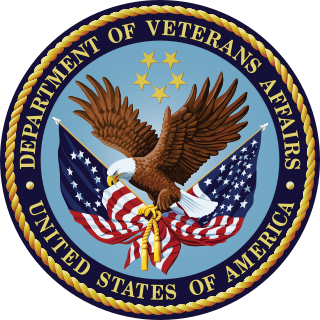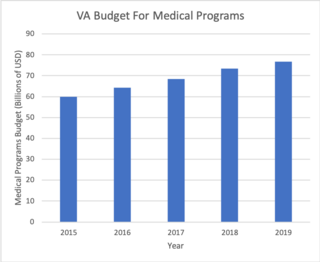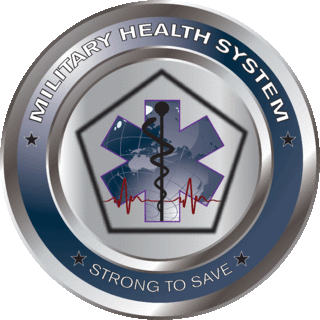
The United States Department of Veterans Affairs (VA) is a Cabinet-level executive branch department of the federal government charged with providing lifelong healthcare services to eligible military veterans at the 170 VA medical centers and outpatient clinics located throughout the country. Non-healthcare benefits include disability compensation, vocational rehabilitation, education assistance, home loans, and life insurance. The VA also provides burial and memorial benefits to eligible veterans and family members at 135 national cemeteries.

The Veterans Health Administration (VHA) is the component of the United States Department of Veterans Affairs (VA) led by the Under Secretary of Veterans Affairs for Health that implements the healthcare program of the VA through a nationalized healthcare service in the United States, providing healthcare and healthcare-adjacent services to Veterans through the administration and operation of 146 VA Medical Centers (VAMC) with integrated outpatient clinics, 772 Community Based Outpatient Clinics (CBOC), and 134 VA Community Living Centers Programs. It is the largest division in the Department, and second largest in the entire federal government, employing over 350,000 employees. All VA hospitals, clinics and medical centers are owned by and operated by the Department of Veterans Affairs as opposed to private companies, and all of the staff employed in VA hospitals are government employees. Because of this, Veterans that qualify for VHA healthcare do not pay premiums or deductibles for their healthcare but may have to make copayments depending on what procedure they are having. VHA is distinct from the U.S. Department of Defense Military Health System of which it is not a part.

The Dwight D. Eisenhower Army Medical Center (EAMC) is a 93-bed medical treatment facility located on Fort Gordon, GA, located near Augusta, Georgia that previously served as the headquarters of the Army's Southeast Regional Medical Command (SERMC). SERMC oversaw the Army's hospitals and clinics within the southeastern United States and Puerto Rico. SERMC was renamed Southern Regional Medical Command (SRMC) and was relocated to San Antonio in 2009.
An employee assistance program generally offers free and confidential assessments, short-term counseling, referrals, and follow-up services for employees. EAP counselors may also work in a consultative role with managers and supervisors to address employee and organizational challenges and needs. Many corporations, academic institution and/or government agencies are active in helping organizations prevent and cope with workplace violence, trauma, and other emergency response situations. There is a variety of support programs offered for employees. Even though EAPs are mainly aimed at work-related issues, there are a variety of programs that can assist with problems outside of the workplace. EAPs have grown in popularity over the years.

The Veterans Benefits Administration (VBA) is an agency of the U.S. Department of Veterans Affairs. It is responsible for administering the department's programs that provide financial and other forms of assistance to veterans, their dependents, and survivors. Major benefits include Veterans' compensation, Veterans' pension, survivors' benefits, rehabilitation and employment assistance, education assistance, home loan guaranties, and life insurance coverage.

Tricare is a health care program of the United States Department of Defense Military Health System. Tricare provides civilian health benefits for U.S Armed Forces military personnel, military retirees, and their dependents, including some members of the Reserve Component. Tricare is the civilian care component of the Military Health System, although historically it also included health care delivered in military medical treatment facilities. Tricare functions similar to a single-payer healthcare system.
Peer support occurs when people provide knowledge, experience, emotional, social or practical help to each other. It commonly refers to an initiative consisting of trained supporters, and can take a number of forms such as peer mentoring, reflective listening, or counseling. Peer support is also used to refer to initiatives where colleagues, members of self-help organizations and others meet, in person or online, as equals to give each other connection and support on a reciprocal basis.
Polytrauma and multiple trauma are medical terms describing the condition of a person who has been subjected to multiple traumatic injuries, such as a serious head injury in addition to a serious burn. The term is defined via an Injury Severity Score (ISS) equal to or greater than 16. It has become a commonly applied term by US military physicians in describing the seriously injured soldiers returning from Operation Iraqi Freedom in Iraq and Operation Enduring Freedom in Afghanistan. The term is generic, however, and has been in use for a long time for any case involving multiple trauma.

The Madigan Army Medical Center, located on Joint Base Lewis-McChord just outside Lakewood, Washington, is a key component of the Madigan Healthcare System and one of the largest military hospitals on the West Coast of the United States.
Military psychiatry covers special aspects of psychiatry and mental disorders within the military context. The aim of military psychiatry is to keep as many serving personnel as possible fit for duty and to treat those disabled by psychiatric conditions. Military psychiatry encompasses counseling individuals and families on a variety of life issues, often from the standpoint of life strategy counseling, as well as counseling for mental health issues, substance abuse prevention and substance abuse treatment; and where called for, medical treatment for biologically based mental illness, among other elements.

The Military Health System (MHS) is a form of nationalized health care operated within the United States Department of Defense that provides health care to active duty, Reserve component and retired U.S. Military personnel and their dependents.

The Army Wounded Warrior Program (AW2) is the official U.S. Army program that assists and advocates for severely wounded, ill or injured Soldiers, Veterans, and their Families and Caregivers, wherever they are located, regardless of military status. Soldiers who qualify for AW2 are assigned to the program as soon as possible after arriving at the Warrior Transition Unit (WTU). AW2 supports these Soldiers and their Families throughout their recovery and transition, even into Veteran status. Through the local, personalized support of AW2 Advocates, AW2 strives to foster the Soldier's independence. There are more than 20,000 severely wounded, ill and injured Soldiers and Veterans currently enrolled in AW2.

Wounded Warrior Project (WWP) is an American charity and veterans service organization that operates as a nonprofit 501(c)(3). WWP offers a variety of programs, services and events for wounded veterans who incurred a physical or mental injury, illnesses, or co-incident to their military service on or after September 11, 2001. Military family members and caregivers are also eligible for WWP programs.
The Defense Centers of Excellence for Psychological Health and Traumatic Brain Injury (DCoE) is a United States Department of Defense (DoD) organization that provides guidance across DoD programs related to psychological health (PH) and traumatic brain injury (TBI) issues. The organization's official mission is to "improve the lives of our nation’s service members, families and veterans by advancing excellence in psychological health and traumatic brain injury prevention and care."
The Naval Center for Combat and Operational Stress Control (NCCOSC) is a U.S. Navy Medicine organization established to promote psychological health in the U.S. Navy and Marine Corps. It is a culturally relevant center that leverages sound medical knowledge to improve resilience, preserve psychological health, improve care for sailors, marines and their families and facilitate Navy Medicine research efforts on psychological health and traumatic brain injury.

The United States has compensated military veterans for service-related injuries since the Revolutionary War, with the current indemnity model established near the end of World War I. The Department of Veterans Affairs (VA) began to provide disability benefits for post-traumatic stress disorder (PTSD) in the 1980s after the diagnosis became part of official psychiatric nosology.
The National Center for Telehealth & Technology (T2) is one of the Defense Centers of Excellence for Psychological Health and Traumatic Brain Injury (DCoE), a part of the Military Health System (MHS). T2 was originally established to lead the integration of behavioural sciences with technology to provide solutions for psychological health and traumatic brain injury (TBI). T2 is a principal coordinator of United States Department of Defense (DoD) initiatives involving telehealth, online health tools, suicide surveillance and prevention, and information technology.
The Chronic Effects of Neurotrauma Consortium or CENC is a federally funded research project devised to address the long-term effects of mild traumatic brain injury in military service personnel (SMs) and Veterans. Announced by President Barack Obama on August 20, 2013, the CENC was one of two major initiatives developed in response to the injuries incurred by U.S. service personnel during Operation Enduring Freedom and Operation Iraqi Freedom. The project is jointly funded in the amount of $62.175 million by the Department of Defense (DoD) and the Department of Veterans Affairs (VA). The CENC is led by Dr. David X. Cifu of the Virginia Commonwealth University.

United States military veteran suicide is an ongoing phenomenon regarding the high rate of suicide among U.S. military veterans in comparison to the general civilian public. A focus on preventing veteran suicide began in 1958 with the opening of the first suicide prevention center in the United States. During the mid-1990s, a paradigm shift in addressing veteran suicide occurred with the development of a national strategy which included several Congressional Resolutions. More advancements were made in 2007, when the Joshua Omvig Veterans Suicide Prevention Act created a comprehensive program including outreach at each Veterans Affairs Office (VA) and the implementation of a 24-hour crisis hotline. PTSD, depression, and combat-related guilt in veterans are often related to suicide as it can be difficult for veterans to transition to civilian life.

Warrior Care Network is a mental health program that provides care, travel, and accommodations at no cost for United States veterans and their families. Treatment options consist of intensive outpatient care, mainly focusing on post-traumatic stress disorder (PTSD) and traumatic brain injury (TBI), military sexual trauma (MST), and related conditions such as anxiety and depression. Warrior Care Network began accepting veterans into the program on January 15, 2016. It was created by a joint effort between Wounded Warrior Project, the U.S. Department of Veterans Affairs and partners consisting of four academic medical research hospitals located throughout the United States. The four programs are Operation Mend at UCLA Health, the Veterans Program at Emory Healthcare, Road Home at Rush University Medical Center, and Home Base, a Red Sox Foundation and Massachusetts General Hospital Program.












